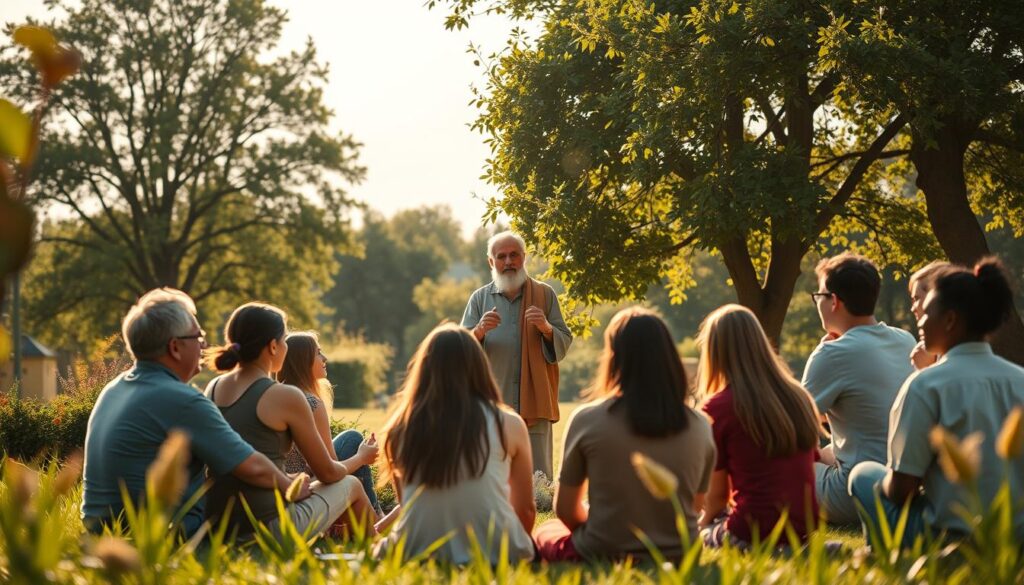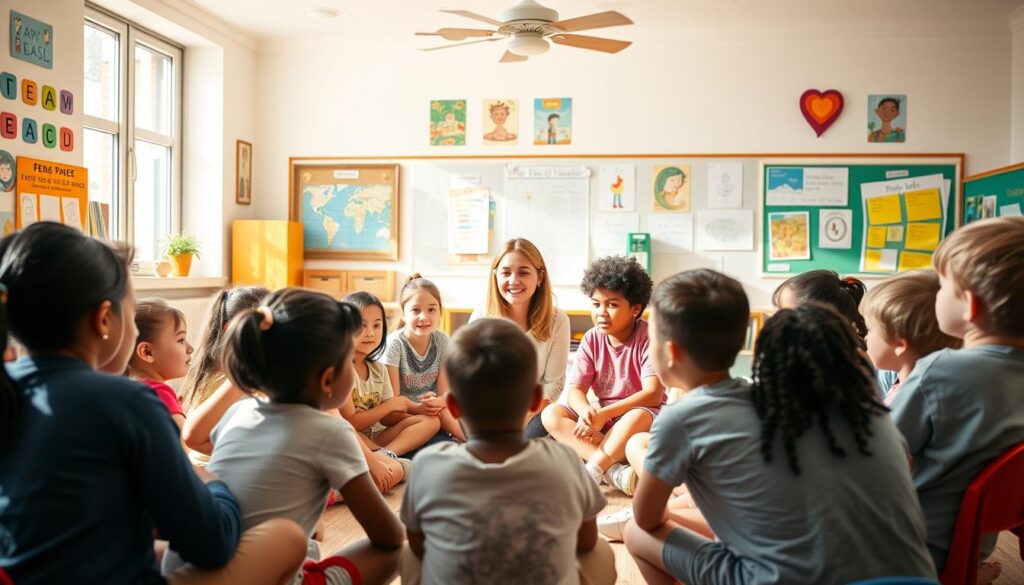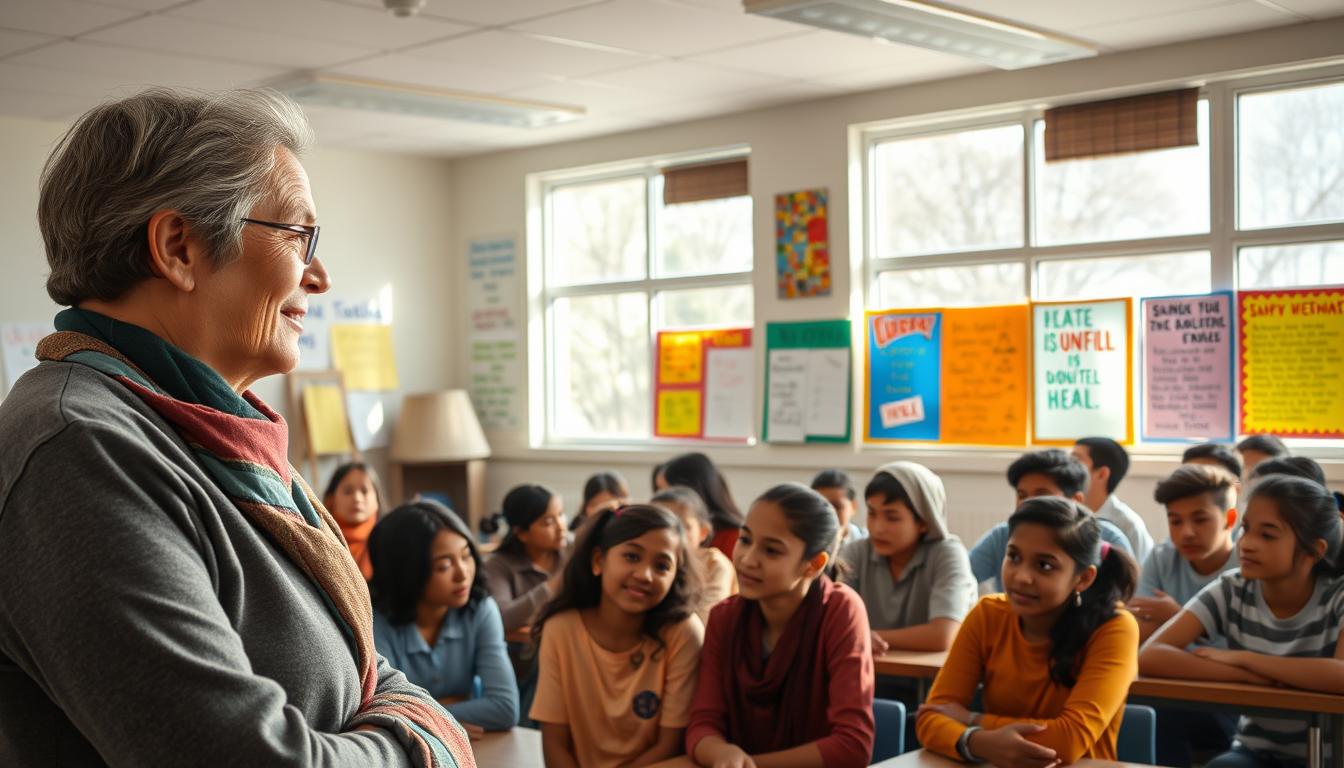In today’s complex and interconnected world, cultivating peaceful coexistence has become increasingly vital. The concept of peace education encompasses more than just the absence of conflict; it involves acquiring values, knowledge, and skills that promote harmony at all levels of society.
As global challenges mount, understanding the role of peace education in fostering a culture of peace is crucial. It serves as a transformative process that equips individuals to address conflicts constructively and promote positive social change. By exploring the multifaceted nature of peace education, we can appreciate its potential to create a more harmonious world.
Table of Contents:
- Understanding Peace Education: Definition and Core Concepts
- The Philosophical Foundations of Peace Education
- Forms and Approaches to Peace Education
- Implementing Peace Education in Schools and Communities
- Challenges and Criticisms of Peace Education
- Conclusion: The Future of Peace Education in a Changing World
Understanding Peace Education: Definition and Core Concepts
Understanding peace education requires delving into its definition and historical context. Peace education is a multifaceted field that has evolved over the years, addressing various global challenges and promoting a culture of peace and nonviolence.
What Is Peace Education?
Peace education encompasses a broad range of themes aimed at cultivating peaceful societies. It includes anti-nuclearism, international understanding, environmental responsibility, and conflict resolution techniques, among others. At its core, peace education seeks to foster the knowledge, skills, and attitudes necessary for building a more peaceful world. By focusing on these areas, peace education programs around the world have represented a spectrum of focal themes since the early 20th century.
Historical Development of Peace Education
The roots of peace education can be traced back to philosophical and religious traditions that emphasized nonviolence and harmonious coexistence. Modern peace education emerged more formally in the aftermath of World War I and II, as educators and peace activists sought ways to prevent future global conflicts. The Cold War era saw peace education focusing heavily on nuclear disarmament and international understanding. Over the years, peace education has continuously evolved, responding to changing global contexts and emerging forms of conflict and violence.
Throughout its development, peace education has maintained its core commitment to fostering more peaceful societies. Recent history shows a growing awareness of structural violence, social justice issues, and the importance of addressing root causes of conflict, further enriching the peace movement.
The Philosophical Foundations of Peace Education
Understanding the philosophical foundations of peace education requires an exploration of its ethical and moral frameworks, as well as its connection to human rights and democracy. Peace education is not merely a practical approach to conflict resolution but is grounded in a rich philosophical basis that informs its methods and goals.
Ethical and Moral Frameworks
The ethical and moral frameworks underpinning peace education are diverse, drawing on various philosophical traditions. As peace education continues to evolve, it incorporates a range of ethical perspectives that emphasize the importance of empathy, compassion, and nonviolence. “Peace education seeks to transform individuals and societies by promoting a culture of peace, tolerance, and understanding,” highlighting the critical role of ethical and moral education in achieving this goal.
These frameworks guide the development of curricula and pedagogies that foster critical thinking, moral reasoning, and emotional intelligence. By integrating ethical and moral education, peace education encourages individuals to consider the impact of their actions on others and to strive for justice and equality.

Connection to Human Rights and Democracy
Peace education shares fundamental connections with human rights education and democratic principles, forming an integrated approach to creating just and peaceful societies. The relationship between peace education and human rights education has strengthened in recent decades, recognizing that respect for human rights is essential for sustainable peace.
As one practitioner noted, “Human rights education does not work in communities fraught with conflict unless it is part of a comprehensive approach.” This underscores the importance of combining peace education with human rights and democracy education to address complex social challenges effectively.
- Peace education promotes understanding of the relationship between peace, justice, and human dignity.
- Democratic values and processes are integral to peace education, providing frameworks for nonviolent conflict resolution and inclusive decision-making.
- The integration of human rights principles into peace education helps address structural violence and systemic injustices.
By fostering a deep understanding of the interdependence of peace, justice, and human rights, peace education contributes to the creation of more just and peaceful societies.
Forms and Approaches to Peace Education
The field of peace education is characterized by a range of forms and approaches that aim to promote peace and conflict resolution. These diverse approaches reflect the complexity of achieving peace in different settings.
Conflict Resolution Training
Conflict Resolution Training is a crucial aspect of peace education. This approach focuses on equipping individuals with the skills to manage and resolve conflicts effectively. By teaching techniques such as mediation, negotiation, and problem-solving, conflict resolution training enables individuals to address disputes constructively.
Democracy and Justice Education
Democracy and Justice Education is another vital component of peace education. This approach emphasizes the importance of promoting democratic values, social justice, and human rights. By educating individuals about their rights and responsibilities, democracy and justice education fosters a culture of equality, fairness, and respect for the rule of law.
Human Rights Education
Human Rights Education is an essential aspect of peace education that focuses on promoting awareness and understanding of human rights. This approach empowers individuals to recognize and respect the rights of others, thereby fostering a culture of dignity and respect.
Worldview Transformation
Worldview Transformation is a critical approach to peace education that involves examining and transforming one’s worldview. According to H.B. Danesh’s “Integrative Theory of Peace,” worldview transformation is essential for achieving sustainable peace. This approach recognizes that conflict often stems from deeply held beliefs and assumptions about “the other,” power, security, and identity.
- Worldview transformation approaches to peace education focus on the deeper psychological and philosophical frameworks that shape how individuals perceive conflict and peace.
- This approach recognizes that sustainable peace requires transforming fundamental assumptions about human nature, reality, and relationships that often unconsciously promote conflict.
- By helping individuals develop more inclusive, cooperative worldviews, this approach aims to create the psychological foundations for peaceful societies.
In conclusion, the various forms and approaches to peace education reflect the complexity of achieving peace in different contexts. By understanding and implementing these approaches, individuals and communities can work towards creating a more peaceful and just world.
Implementing Peace Education in Schools and Communities
Implementing peace education effectively in schools and communities involves strategic planning, resource allocation, and a commitment to creating a culture of peace. As emphasized by Ms. Yanka Takeva, President of the Bulgarian Teacher Union, “It is very important that we understand the role of education and teachers in today’s world of conflicts. We must make peace education and conflict solution an integral part of the curriculum and give teachers the necessary support and training.”

Curriculum Integration Strategies
To integrate peace education into the curriculum, schools can adopt a holistic approach that incorporates peace education into various subjects. This can involve revising existing curricula to include topics related to conflict resolution, human rights, and democracy. By doing so, students can develop a deeper understanding of peaceful values and practices. Effective curriculum integration also requires collaboration among teachers, administrators, and community members to ensure a cohesive and comprehensive approach.
- Incorporating peace education into existing subjects
- Developing standalone peace education courses
- Encouraging project-based learning that promotes peace and nonviolence
Teacher Training and Development
Teacher training is a critical component of successful peace education implementation. As Martin Rømer, ETUCE European Director, noted, “As teachers, we have a huge responsibility to teach young people about alternatives by showing that there are better ways to solve conflicts rather than violence.” Providing teachers with the necessary training and resources enables them to effectively integrate peace education into their teaching practices. This can include workshops on conflict resolution, peace education methodologies, and classroom management techniques that promote a peaceful learning environment.
Creating Peaceful Learning Environments
Creating peaceful learning environments is essential for the effective implementation of peace education. This involves establishing physical spaces, social norms, and institutional policies that model and reinforce peaceful values and practices. Some strategies include implementing restorative approaches to discipline, promoting democratic classroom practices, and designing physical environments that foster collaboration and reduce stress. By creating such environments, schools can strengthen the impact of peace education and promote a culture of peace among students and staff.
- Implementing restorative approaches to discipline
- Promoting democratic classroom practices
- Designing peaceful physical environments
Challenges and Criticisms of Peace Education
Peace education, as a concept, is confronted with several criticisms and challenges that need examination. While it aims to promote peace and understanding, its implementation is not straightforward.
Theoretical and Practical Limitations
One of the significant challenges peace education faces is the gap between theory and practice. As noted by Salomon (2002), the goals and methods of peace education vary substantially across different contexts, such as areas of intractable conflict, interethnic tension, or relative tranquility. Human rights education, a component of peace education, “faces continual elaboration, a significant theory-practice gap and frequent challenge as to its validity.” This discrepancy can lead to ineffective or even counterproductive outcomes if not addressed properly.
For instance, human rights education can increase awareness of unmet rights, potentially escalating conflict in communities fraught with tension. Therefore, it’s crucial to adopt a comprehensive approach that considers the specific context and needs of the community.
Cultural and Contextual Considerations
Peace education programs developed in one cultural context may not be directly applicable to different settings without appropriate adaptation. The effectiveness of peace education varies significantly across contexts, particularly between regions experiencing active conflict, post-conflict recovery, or relative stability.
- Cultural differences in conflict resolution styles and communication patterns require thoughtful adaptation of peace education approaches.
- Power dynamics and historical injustices within societies can complicate peace education efforts, especially when programs fail to address underlying structural violence.
- In conflict zones, peace education may face resistance from communities where immediate security concerns take precedence over long-term educational goals.
To overcome these challenges, it’s essential to develop locally relevant approaches that respond to specific community needs while drawing on broader peace education principles. This tailored approach can enhance the effectiveness and sustainability of peace education initiatives.
Conclusion: The Future of Peace Education in a Changing World
As we navigate the complexities of the modern world, peace education emerges as a crucial element in shaping a more harmonious future. The European Trade Union Committee for Education (ETUCE) actively promotes common values such as peace, mutual respect, solidarity, and democracy in the education sector, encapsulating these pillars in the concept of Peace Education.
Looking ahead, peace education faces new challenges and opportunities in our rapidly changing global landscape. Emerging technologies, shifting geopolitical dynamics, and environmental concerns will shape the context in which peace education operates. The field must adapt, integrating digital tools, emphasizing environmental peace education, and connecting formal and informal learning contexts.
By fostering critical thinking, empathy, and conflict resolution skills, peace education equips new generations to address challenges to peace. As global citizens, we all have a role to play in supporting and advancing peace education as part of creating a more peaceful world. The future effectiveness of peace education depends on its ability to evolve while maintaining core commitments to nonviolence, justice, and human dignity.

